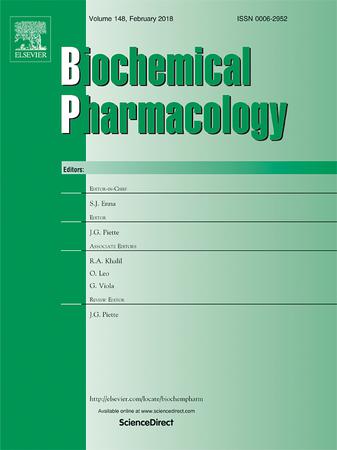Ghrelin/GHSR系统减轻小鼠胶原诱导的关节炎,并改善人类类风湿关节炎成纤维细胞样滑膜细胞的炎症
IF 5.6
2区 医学
Q1 PHARMACOLOGY & PHARMACY
引用次数: 0
摘要
胃饥饿素是一种酰化的肽激素,通过其唯一已知的受体——生长激素促分泌受体(GHSR)起作用。先前的研究表明ghrelin可能参与类风湿关节炎(RA),但具体机制尚不清楚。本研究旨在探讨胃饥饿素在RA滑膜炎症中的作用机制。采集RA患者血清和滑膜组织进行胃饥饿素表达分析。我们使用胶原诱导的关节炎(CIA)小鼠模型和肿瘤坏死因子-α (TNF-α)诱导的成纤维细胞样滑膜细胞(FLSs)体外模型进行了研究。进行rna测序以确定与RA相关的潜在信号通路。Ghsr shRNA干扰被用来评估是否参与ghrelin受体。RA患者滑膜组织中Ghrelin表达降低,与滑膜液中TNF-α呈负相关。在体内实验中,酰基胃饥饿素有效地抑制了CIA的发展,Ghsr - / -小鼠表现出CIA小鼠关节炎症状的显著加重。Ghsr - / -和野生型小鼠滑膜组织RNA序列分析表明,ghrelin/ Ghsr系统可能通过PI3K/AKT通路抑制炎症。在RA-FLSs中,我们发现酰基胃饥饿素显著抑制TNF-α诱导的RA-FLSs中p-PI3K、p-AKT、p-NF-κB p65、IL-6和IL-1β的升高。PI3K/AKT激动剂可减弱乙酰胃饥饿素对炎症因子的影响。Ghsr shRNA逆转了酰基饥饿素的抗炎作用。这些结果表明,ghrelin/GHSR系统在RA中具有重要作用,可能是治疗RA的合适候选系统。本文章由计算机程序翻译,如有差异,请以英文原文为准。

Ghrelin/GHSR system attenuates collagen-induced arthritis in mice and ameliorates inflammation in human rheumatoid arthritis fibroblast-like synoviocytes
Ghrelin, an acylated peptide hormone, acts through its sole known receptor, the growth hormone secretagogue receptor (GHSR). Previous research indicated that ghrelin may be involved in rheumatoid arthritis (RA), yet the specific mechanisms remain unclear. This study aimed to explore the mechanism of ghrelin in RA synovial inflammation. Serum and synovial tissue from RA patients were collected for ghrelin expression analysis. We conducted our study using a collagen-induced arthritis (CIA) mouse model and an in vitro model using fibroblast-like synoviocytes (FLSs) induced by tumor necrosis factor-alpha (TNF-α). RNA-sequencing was performed to identify the potential signaling pathways involved in RA. Ghsr shRNA interference was used to assess whether the ghrelin receptor was involved. Ghrelin expression was decreased in synovial tissue of RA patients, and was negatively associated with TNF-α in the synovial fluid. In vivo experiments, acyl-ghrelin effectively suppressed CIA development, and Ghsr−/− mice exhibited the significantly aggravated arthritis symptoms of CIA mice. RNA sequence analyses of synovial tissue in Ghsr−/− and wild type mice indicated that ghrelin/GHSR system may inhibit inflammation through the PI3K/AKT pathway. In RA-FLSs, we found that acyl-ghrelin significantly suppressed the TNF-α induced increase in p-PI3K, p-AKT, p-NF-κB p65, IL-6 and IL-1β in RA FLSs. The effects of acyl-ghrelin on inflammatory factors were attenuated by the PI3K/AKT agonists. Ghsr shRNA reversed the anti-inflammatory effects of acyl-ghrelin. These results indicated that ghrelin/GHSR system has an important role in RA and could be a suitable candidate for RA therapy.
求助全文
通过发布文献求助,成功后即可免费获取论文全文。
去求助
来源期刊

Biochemical pharmacology
医学-药学
CiteScore
10.30
自引率
1.70%
发文量
420
审稿时长
17 days
期刊介绍:
Biochemical Pharmacology publishes original research findings, Commentaries and review articles related to the elucidation of cellular and tissue function(s) at the biochemical and molecular levels, the modification of cellular phenotype(s) by genetic, transcriptional/translational or drug/compound-induced modifications, as well as the pharmacodynamics and pharmacokinetics of xenobiotics and drugs, the latter including both small molecules and biologics.
The journal''s target audience includes scientists engaged in the identification and study of the mechanisms of action of xenobiotics, biologics and drugs and in the drug discovery and development process.
All areas of cellular biology and cellular, tissue/organ and whole animal pharmacology fall within the scope of the journal. Drug classes covered include anti-infectives, anti-inflammatory agents, chemotherapeutics, cardiovascular, endocrinological, immunological, metabolic, neurological and psychiatric drugs, as well as research on drug metabolism and kinetics. While medicinal chemistry is a topic of complimentary interest, manuscripts in this area must contain sufficient biological data to characterize pharmacologically the compounds reported. Submissions describing work focused predominately on chemical synthesis and molecular modeling will not be considered for review.
While particular emphasis is placed on reporting the results of molecular and biochemical studies, research involving the use of tissue and animal models of human pathophysiology and toxicology is of interest to the extent that it helps define drug mechanisms of action, safety and efficacy.
 求助内容:
求助内容: 应助结果提醒方式:
应助结果提醒方式:


